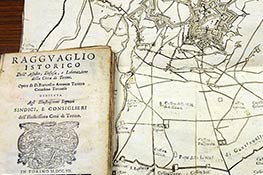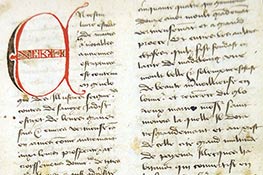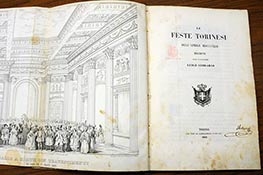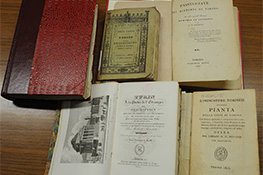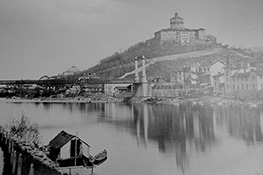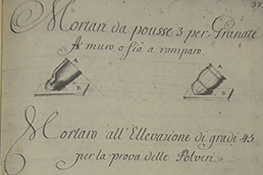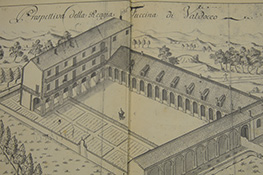Versione italiana English version Version française Versión en español
History texts, photographs, illustrated tables and drawings, guides to places and people, a whole specific topography of the city and its surroundings: a collection of rare and often ancient texts on Turin that the Historical Library preserves have been digitized and put in place. available on the Turin Museum project website. Below we would like to point out some of the most relevant.
History
An eldest manuscript of half XV century in French language tells the story of Hause Savoy from the origins to Amedeo VI. It is composed by 115 papers written in semi gothic writing on two columns, with red and black ink. The decorated drop caps are really beautiful.
Historia di Torino con una succinta descrittione di tutti li Stati della Casa di Savoia (Padova, Pasquati 1676) was written by Giovanni Andrea Pauletti (Padova 1641-1705), historian and archivist. An unusual topic, since Savoy state was not really important in that period: but Pauletti was recognized to be a spy under the service of Carlo Emanuele II, to whom the work is dedicated, and so, a year later, he was arrested and imprisoned in the gates of Padova republic. A map of Turin Citadel and its area is included in the Ragguaglio istorico dell'assedio, difesa e liberazione di Torino by Francesco Antonio Tarizzo priest of Favria, author of the small poem in Piedmont dialect titled L'arpa dëscordà, in which is told in almost two thousand verses the story of the siege and the liberation of Turin in 1706. Ragguaglio is the precious witness written in prose of all this.
By baron Gaudenzio Claretta (Turin 1835 - Rome 1900) the Library preserves a lot of material kept in Claretta Fund, really important concerning heraldry and subalpine historiography. Historian and passionate researcher of unpublished documents, Claretta was author of many scripts, often monographic, about Piedmont history and its characters, such as Il Municipio torinese ai tempi della pestilenza del 1630 e della reggente Cristina di Francia duchessa di Savoia (Torino, 1869). Note that Claretta himself did also write a monograph dedicated to Gian Francesco Bellezia, mayor of Turin, who, during the pandemic, stayed in the city to face the emergency and to fight the disease with priests and doctors, among whom Gian Fancesco Fiocchetto.
A Storia dell'antica Torino "Julia Augusta Taurinorum" (Torino, 1869), with a map of the roman Turin, that tells the tales from the age of the Taurini people until the age of the Longobards, dealing with architectural, urban, administrative and militar factors, is due to the wide interests of the author, the architect, archeologist and philologist Carlo Promis (Torino 1808-1873). Promis is known for his studies of many archaeological sites, such as the Luni and Alba Fucens ones at the feet of mount Velino, and for the architectural project regarding the entrance building to the Porta Susa station in Turin.
The long celebrations (a whole month) in Turin for the wedding of Vittorio Emanuele di Savoia with the daughter of Lombardo-Veneto viceroy, Maria Adelaide di Asburgo-Lorena, are the topic of a small book titled Le feste torinesi dell'aprile 1842. The author is the famous historian and politic man Luigi Cibrario (Turin 1802 - Trobiolo 1870). The wedding, celebrated the 12th of April, was feasted with dances, fireworks, a tournament, and for the occasion the Holy Shroud was exposed. The description of the events includes many lithographies that represent them. The book also contains an Ode by Silvio Pellico and a Carme by Felice Romani (the librettist of Bellini, Rossini, Donizetti, who was also the director of the official Piedmont Gazette from 1834 to 1849).
Vintage turism: people and places
Giuseppe Francesco Baruffi (1801-1875), monregalese, of whom the historical Library preserves an archival Fund, was a passionate expert of natural sciences and carried out an intense activity of scientific divulgation and modernization in the social and economic fields. He was author of some travel diaries (published with the title Pellegrinazioni autunnali) and of fifteen brochures published between 1853 and 1861, the Passeggiate nei dintorni di Torino, of which the last of the series is signalized.
By Reycend Brothers, a famous publishing house from Turin, Two interesting historical-descriptive guides were published, written by lawyer Modesto Paroletti, secretary of the Provisional Government in Turin in 1798-99, coworker of Carlo Botta in the Legislature of the Empire from 1807 to 1811 and founder of the Jacobin magazine Il Repubblicano piemontese. They are: Turin et see curiositès, ou description historique de tout ce que cette capitale offre de remarquable dans ses monumens, ses édifices et ses environs (1819), a guide complete with historical maps of the city during its development from XV century, and Turin à la Porte de l'Etranger (1834), touristic guide in which Paroletti provides to the print some illustrations included in Vues de la Ville de Turin et de ses Environs (Reycend, 1825), rare gathering holding 16 papers with perspectival views engraved in copper by Luigi Valperga and Alessandro Rivelanti from drawings by Marco Nicolosimo: Turin squares, Superga, Rivoli castles, Stupinigi, Moncalieri and Racconigi.
An interesting vintage guide is the one printed by the printing house Marietti, Dieci giorni in Torino ossia descrizione antica e moderna della città (1831), which describes the main monuments and places illustrated in a serie of engravings.
To Giovanni Giuseppe Reycend, belonging to the fifth generation of book sellers - editors migrated in Piedmont from the Dauphine in the seventeenth century, it is also due the print of the Indicatore torinese (1815, and then 1821), precious "alphabetic and categoric list" in which the population is registered by the job, with indicated address. Decorated by a copper engraving showing the "Demonstrative plant of the City of Turin" with the indication of the "isles" by which the city was divided into, represents the leader, for the ‘800s, of the popular guides Marzorati-Paravia.
Maps and sights
Apart from the already named Vues published by Reycend Brothers, squares of Turin and castles in the area are shown in the 24 boards printed by Marietti in 1836 with the title Monumenti e siti pittoreschi della città e contorni di Torino. The author of the drawings is Enrico Gonin (1799), lithographer from Turin, brother of the painter and lithographer himself Francesco Gonin (Turin 1808-1889). Enrico worked with Felice Festa who opened the first lithograph agency in Turin in 1824.
Belonging to the painter Carlo Bossoli there are 13 boards printed in 1854 with sights of the Savoy capital: Bossoli (Lugano 1815 - Turin 1884) used to work a lot in Turin for the Savoia family, who commissioned him 105 tempera paintings dedicated to the wars that took place in the years 1859-60-61, still exposed in Palazzo Carignano. The volume Turin ancien et moderne is really interesting, printed in 1867 and including 20 photographic boards introduced by descriptions and comments (in French language) signed by Cibrario, Bersezio, Sclopis, Baruffi and others. The shots belong to Henri Le Lieure (Nantes 1831 - Rome 1914), who moved in Turin around 1860, opening his first studio with the name "Photographie Parisienne" at the Caffè of the Public Garden, and then in via della Rocca and soon becoming the favorite photographer of the Savoy court and the Piedmont aristocracy.
After the unification of Italy he moved to Rome where he first started the projections for the Lumière Cinema, the 13th of March 1896.
Regarding the drawings, there is the valuable anastatica of the Nuove Arti Grafiche (1981), about the Royal Arsenal of Turin in 1700, that reproduces a manuscript preserved at the School of Application of Turin. The work is titled Disegni d'ogni sorta de cannoni, et mortari con tutte le pezze, stromenti et utigli appartenenti all'artiglieria come anco le piante, alzate, et profili di tutte le macchine, edifizy, et ordigni necessary per la medesima (1732).
The drawings are made by Givanni Battista d'Embser, official of artillery who took part to the Turin siege in 1706. In the end, 22 boards gathered in an album of 1869 show the floor plans of the market sites.
The drawings are original made with pencil and watercolor, moreover there is a lithography with the Pianta dell'ammazzatoio generale della città di Torino dated 1st of January 1868.
It is a rare gathering that constitutes a precious pool of information for the history and the topography of Turin markets in that period.

